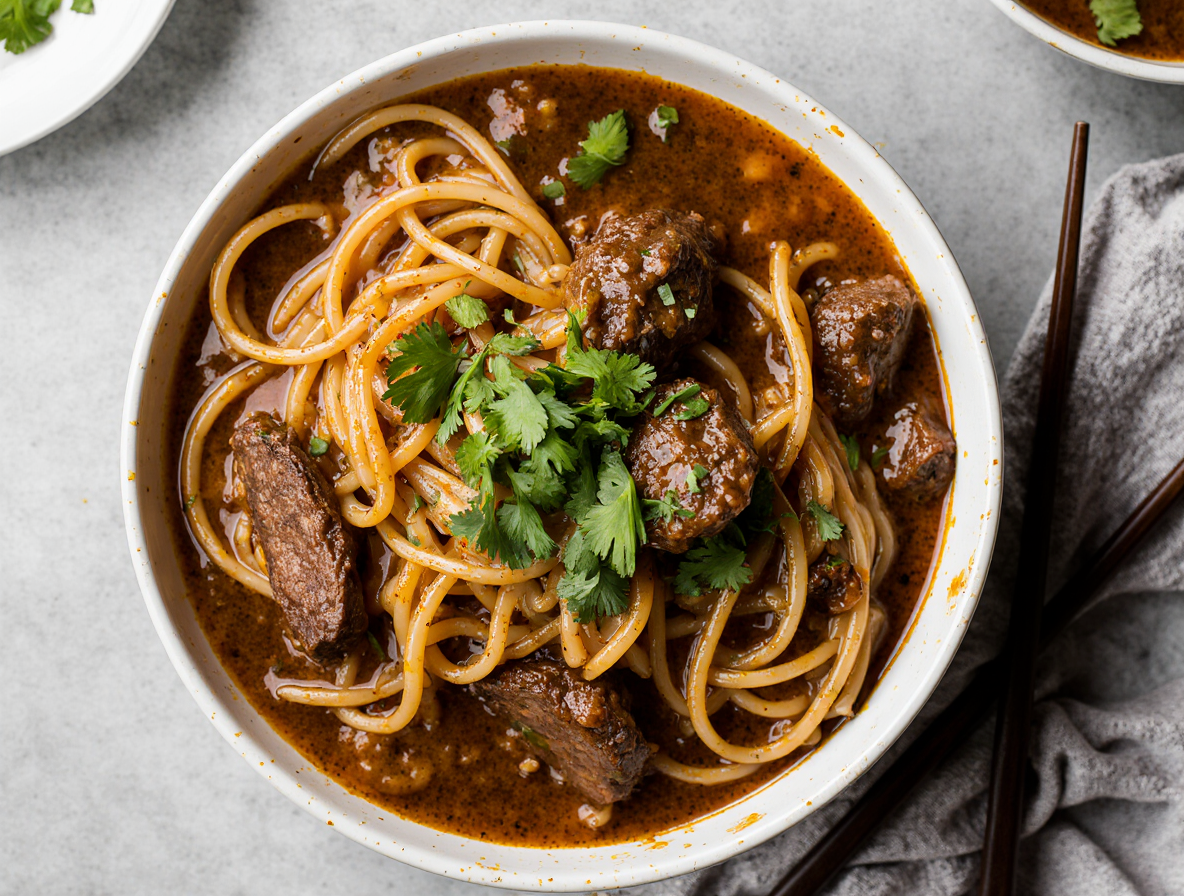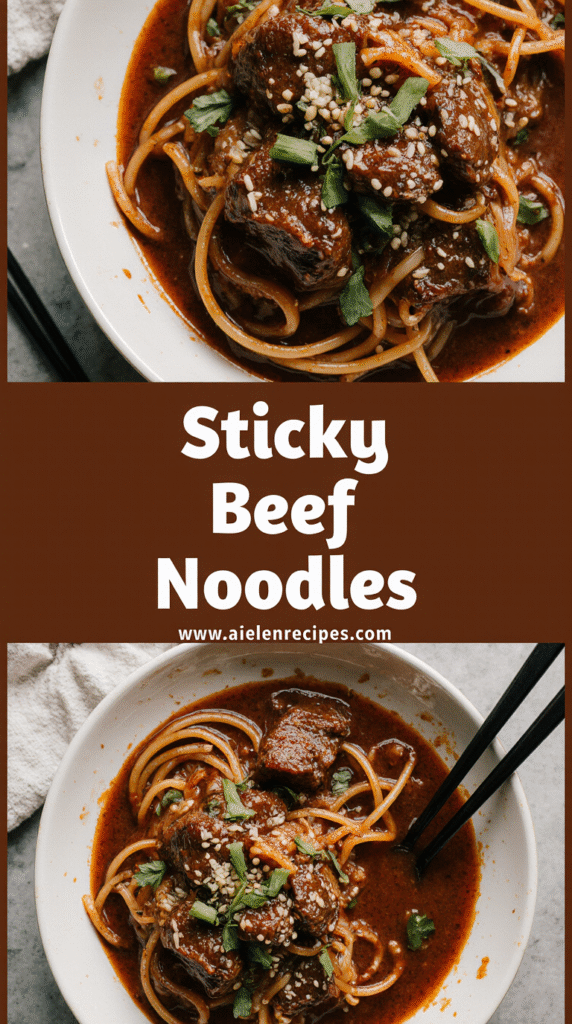The Secret to Perfect Asian Beef Noodles (Chef-Approved Recipe)
Asian beef noodles actually take just 15 minutes to prepare, making them perfect for those nights when you’re craving something delicious but short on time. I’ve found that this one-pan sticky beef noodles recipe consistently delivers restaurant-quality results with minimal effort and cleanup.
What makes this dish particularly special is the combination of tender beef, chewy noodles, and that irresistibly savory sauce that coats every bite. Furthermore, this asian beef noodles stir fry requires only simple, low-cost ingredients while still delivering maximum flavor. Whether you’re new to cooking asian beef recipes with noodles or looking to perfect your sticky beef recipe technique, this chef-approved version will transform your weeknight dinner routine.
In this guide, I’ll walk you through everything you need to know to create the perfect sticky noodles recipe at home. From selecting the right cut of beef to balancing those sweet, salty, and umami flavors, we’ll cover all the chef-approved tips that elevate this dish from good to exceptional. Best of all, you’ll have a nutritious, delicious meal on the table in under 30 minutes.
Choosing the Right Ingredients for Asian Beef Noodles
The foundation of exceptional asian beef noodles lies in selecting the right ingredients. Creating a restaurant-quality dish at home hinges on understanding which components work together harmoniously.
Best cuts of beef for stir-fry
Flank steak reigns as the most popular choice for asian beef noodles stir fry. It delivers intense beefy flavor and responds well to proper slicing and marinating. Sirloin steak provides a worthy alternative with similar tenderness characteristics.
Surprisingly, boneless beef chuck steak offers an economical option that can be just as tender as pricier cuts when prepared correctly. In fact, in side-by-side tests, chuck steak matched the tenderness of sirloin and scotch filet despite costing significantly less ($3.75 compared to $16.00 for premium cuts).
For any cut chosen, slicing technique matters tremendously. Cut your beef against the grain (perpendicular to the muscle fibers) into thin strips no thicker than 3mm (⅛”). This single technique can transform even tougher cuts into tender morsels.
Types of noodles that work well
Rice noodles excel in asian beef recipes with noodles because they don’t easily turn mushy and absorb flavors beautifully. Ramen or instant noodles provide convenience and quick cooking times, making them ideal for weeknight sticky noodles recipes.
Additionally, udon, soba, lo mein, and even regular spaghetti can substitute effectively. Each brings different textures—udon offers chewiness, soba provides earthiness, while lo mein delivers that classic takeout experience.
Essential sauce components
The magic of asian beef noodles happens in the sauce. Essential ingredients include:
- Soy sauce (preferably low-sodium)
- Oyster sauce (vegetarian versions available)
- Hoisin sauce for sweetness
- Sesame oil for nutty aroma
- Rice vinegar for acidity
- Garlic and ginger for aromatic foundation
Dark soy sauce provides deeper color and more intense flavor than regular soy sauce. Mirin (sweet Japanese cooking wine) adds subtle sweetness that balances saltiness.
Vegetables that add texture and color
The beauty of asian beef noodles stir fry lies in its adaptability. Bean sprouts add crunch and freshness, while bell peppers contribute vibrant color and sweetness.
Other excellent additions include:
- Broccoli or bok choy for green crispness
- Carrots (julienned or shredded) for color and sweetness
- Mushrooms for umami depth
- Snow peas or sugar snap peas for bright crunch
- Green onions for sharp, fresh flavor
For a quick sticky beef recipe, onions, garlic, and bean sprouts require minimal chopping. Cabbage makes an excellent substitute when bean sprouts aren’t available.
Step-by-Step Guide to the Perfect Stir-Fry
Mastering the technique is what separates good asian beef noodles from great ones. Let’s break down the process into manageable steps to ensure perfect results every time.
1. Marinate the beef for flavor and tenderness
The secret to restaurant-quality asian beef noodles lies in properly marinating the meat. Mix your thinly sliced beef with a combination of cornstarch, water, and a small amount of oil. This technique, known as “velveting,” creates a protective coating that locks in moisture during cooking. For extra tenderness, add ½ teaspoon of baking soda per pound of beef—just be careful not to use too much or you’ll end up with soapy-tasting meat. Allow the beef to marinate for at least 15-30 minutes, or overnight for deeper flavor penetration.
2. Prepare the sauce in advance
Before heating your wok, mix all sauce ingredients in a separate bowl. This prevents scrambling to measure ingredients while stir-frying, which happens quickly. If using cornstarch for thickening, ensure it’s fully dissolved in cool liquid before adding to prevent clumping. A properly prepared sauce should have balanced sweet, salty, and umami flavors ready to coat your noodles perfectly.
3. Cook noodles just right
Follow package directions but subtract one minute from the recommended cooking time. The noodles will finish cooking when combined with the sauce later. After cooking, immediately rinse under cold water to stop the cooking process and remove excess starch—this essential step prevents sticky, clumpy noodles in your final dish.
4. Stir-fry beef and vegetables separately
Heat your wok or large skillet until it’s nearly smoking before adding oil. Cook marinated beef first until about 80% done (still slightly pink), then remove it from the pan. Next, stir-fry vegetables in order of cooking time—harder vegetables like carrots first, followed by softer ones like mushrooms or bell peppers. This prevents overcooking delicate ingredients.
5. Combine everything with the sauce
Return beef to the pan, add the sauce, then incorporate the partially cooked noodles. Toss continuously using a circular motion so ingredients hit the hot sides of the wok, creating that coveted “wok hei” flavor. Continue tossing until the sauce thickens and evenly coats everything. The entire process from combining to serving should take no more than 2-3 minutes to prevent overcooking the noodles.
Chef Tips to Elevate Your Sticky Beef Noodles
Professional chefs possess secrets that transform ordinary asian beef noodles into extraordinary culinary experiences. Throughout my years cooking alongside top chefs, I’ve learned techniques that make all the difference in creating restaurant-quality dishes at home.
Cutting beef against the grain
The most crucial technique for tender beef lies in how you slice it. Look closely at your meat to identify the muscle fibers running in parallel lines—this is the “grain.” Always cut perpendicular to these lines, essentially shortening the fibers into smaller segments. This single technique can transform even tougher cuts into melt-in-your-mouth morsels. For stir-fries specifically, aim for slices no thicker than ¼ inch, maintaining a 45° angle with your knife to create wider, more tender pieces.
Getting the pan hot enough
Professional kitchens use the phrase “scary hot” for a reason. Your wok or pan should be preheated until it’s almost smoking before adding oil. This intense heat creates proper caramelization, developing depth and complexity in your asian beef noodles stir fry. When ingredients hit the pan, you should hear an immediate sizzle—anything less means your pan isn’t hot enough. Consequently, select oils with high smoke points like peanut, canola, or vegetable oil.
Balancing sweet, salty, and umami flavors
Every memorable sticky beef recipe requires perfect flavor balance. The foundation typically includes:
- Soy sauce (provides saltiness)
- Oyster or hoisin sauce (delivers umami depth)
- A small amount of sugar (balances saltiness)
- Aromatics like garlic and ginger (adds complexity)
Even just one teaspoon of sugar makes a significant difference in balancing bold flavors. Notably, avoid salting your meat too early as this will draw out moisture, resulting in gray, overcooked beef.
How to avoid soggy noodles
Perfectly textured sticky noodles require careful timing. Undercook noodles slightly as they’ll continue softening in the sauce. Immediately after boiling, rinse under cold water to halt cooking and remove excess starch. Essentially, separate your noodles from sauce until serving time—especially with crispy noodle dishes. Lastly, consume your asian beef recipes with noodles promptly, as starch continues working over time, inevitably softening the texture.
Storage, Reheating, and Make-Ahead Tips
Properly handling leftovers extends the enjoyment of your asian beef noodles beyond a single meal. With the right storage and reheating techniques, you’ll maintain those perfect flavors and textures for days to come.
How to store leftovers properly
For optimal freshness, allow your asian beef noodles stir fry to cool to room temperature before storing—typically 15-20 minutes is sufficient. This prevents condensation that leads to soggy noodles. Always use airtight containers to preserve flavor and prevent odors from permeating your dish. Store leftovers in the refrigerator within two hours of cooking to maintain food safety.
Most sticky beef noodles recipes stay fresh for 3-4 days when properly refrigerated. For best results, separate components when possible—keeping noodles, beef, and vegetables in different containers helps maintain their individual textures.
Best way to reheat without drying out
The stovetop method reigns supreme for reheating asian beef recipes with noodles. Heat a pan over medium heat, add your leftovers with a tablespoon of broth or water, then gently toss until heated through. This technique revives the original texture while preventing dryness.
When using a microwave, sprinkle water over your sticky noodles recipe and heat on medium power for short intervals, stirring between each. Avoid high heat settings, as these can overcook the beef and turn noodles mushy.
Can you freeze sticky beef noodles?
Indeed, you can freeze asian beef noodles for up to 2-3 months. However, the texture changes significantly upon thawing—noodles typically become softer and vegetables lose crispness. For better results, freeze only the beef and sauce components separately.
When ready to enjoy, thaw frozen components overnight in the refrigerator. Never thaw at room temperature, as this creates food safety risks. Subsequently, prepare fresh noodles to combine with your thawed sticky beef recipe for optimal texture.
Prepping ingredients ahead of time
Making components in advance saves considerable time without sacrificing quality. Prepare your sauce up to one day ahead and store refrigerated in an airtight container. This step alone eliminates significant prep time during cooking.
Moreover, marinating beef overnight not only saves time but actually improves flavor. Chop vegetables hours before cooking and store them covered in the refrigerator. Together with prepared sauce and marinated meat, this advance preparation transforms your asian beef noodles from a time-consuming project into a quick weeknight meal that tastes like it took hours.
Conclusion
Asian beef noodles truly deserve a spot in your regular meal rotation. Throughout this guide, we’ve explored how this delicious dish combines simplicity and flavor while requiring minimal time investment. Undoubtedly, the magic lies in mastering a few fundamental techniques rather than complicated cooking methods.
Remember, proper beef slicing makes all the difference. Cutting against the grain transforms even budget-friendly cuts into tender, restaurant-quality meat. Additionally, that perfectly balanced sauce brings everything together – sweet, salty, and umami flavors working harmoniously to coat each noodle.
The beauty of this recipe extends beyond just dinner night. Leftovers store wonderfully for several days when handled correctly. Therefore, you might consider doubling the recipe next time for quick, delicious meals throughout your busy week.
What makes this dish particularly special is its adaptability. You can customize your asian beef noodles based on available ingredients, personal preferences, or dietary needs. Essentially, this recipe provides a framework you can adjust endlessly while maintaining that authentic flavor profile.
Last but certainly not least, practice makes perfect. Your first attempt might not match your favorite takeout immediately, but each time you prepare this dish, you’ll develop more confidence with high-heat cooking and flavor balancing. Soon enough, you’ll find yourself reaching for this recipe instead of the delivery menu – saving money while enjoying fresher, healthier meals made exactly how you like them.
Now that you have all these chef-approved techniques at your fingertips, your homemade asian beef noodles will surely impress family and friends alike. Consequently, you might just become the go-to noodle expert in your social circle!
FAQs
Q1. What’s the key to achieving tender beef in Asian noodle dishes? The secret lies in cutting the beef against the grain into thin strips, no thicker than 1/4 inch. This technique shortens the muscle fibers, resulting in more tender meat, even when using less expensive cuts.
Q2. How can I prevent my noodles from becoming soggy in stir-fries? To avoid soggy noodles, cook them for one minute less than the package instructions suggest. Immediately rinse them under cold water to stop the cooking process and remove excess starch. Add the noodles to the stir-fry only at the very end of cooking.
Q3. What are the essential components for a flavorful Asian noodle sauce? A well-balanced sauce typically includes soy sauce for saltiness, oyster or hoisin sauce for umami, a small amount of sugar for sweetness, and aromatics like garlic and ginger for complexity. Adjust these components to achieve the perfect balance of flavors.
Q4. Can I prepare parts of the dish in advance to save time? Absolutely! You can prepare the sauce up to a day ahead and store it in the refrigerator. Marinating the beef overnight not only saves time but also enhances the flavor. Vegetables can be chopped hours before cooking and stored in the refrigerator.
Q5. What’s the best method for reheating leftover Asian beef noodles? The stovetop method works best. Heat a pan over medium heat, add your leftovers with a tablespoon of broth or water, and gently toss until heated through. This method helps revive the original texture while preventing the dish from drying out.


